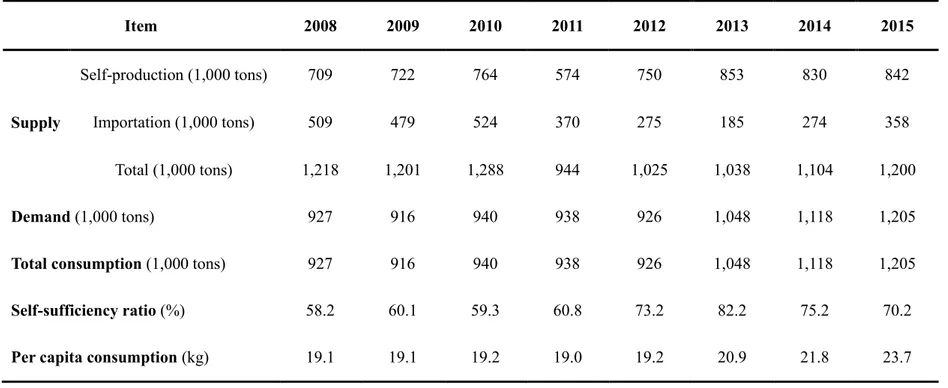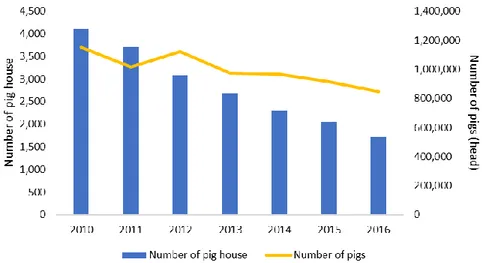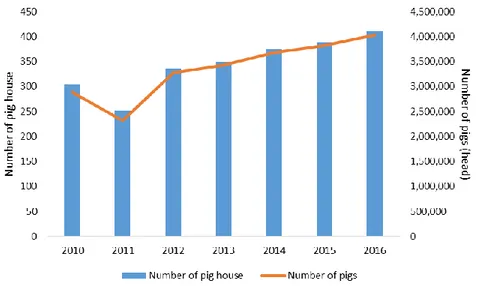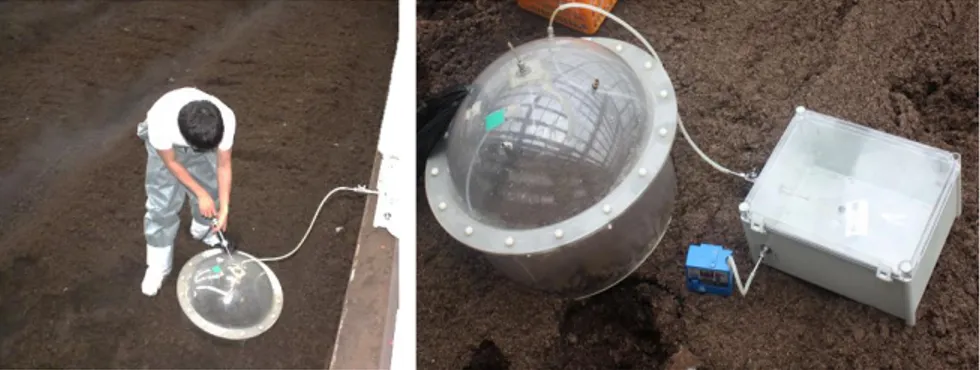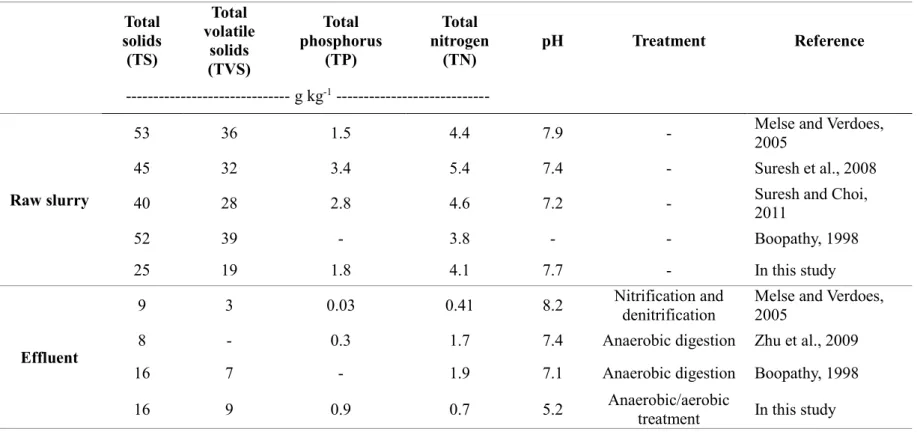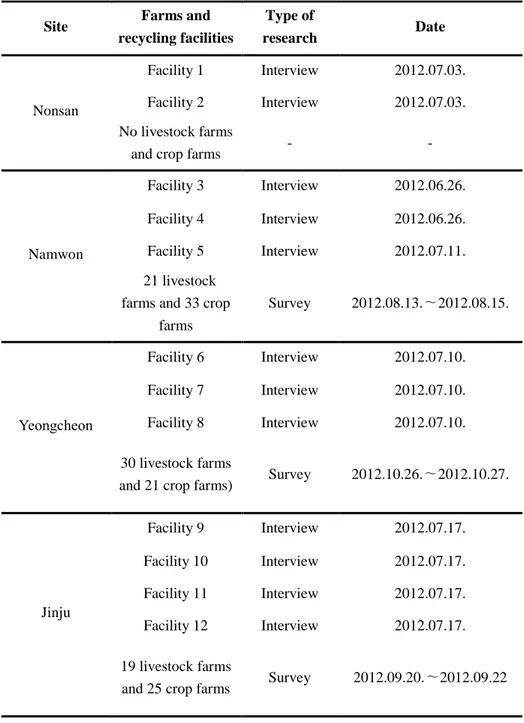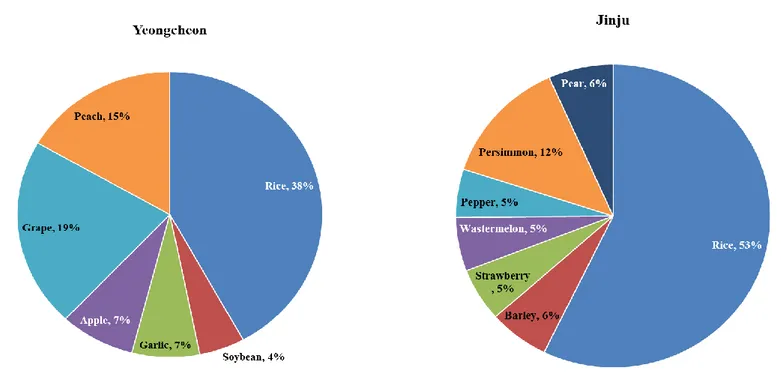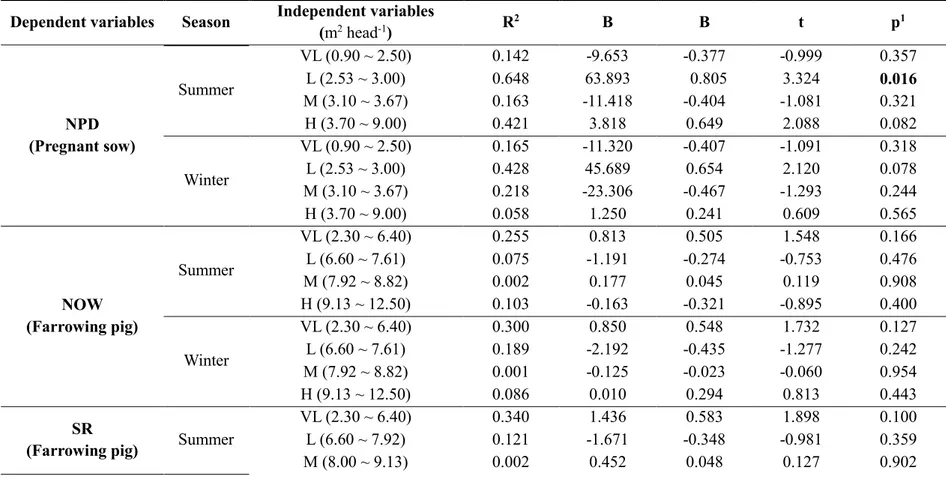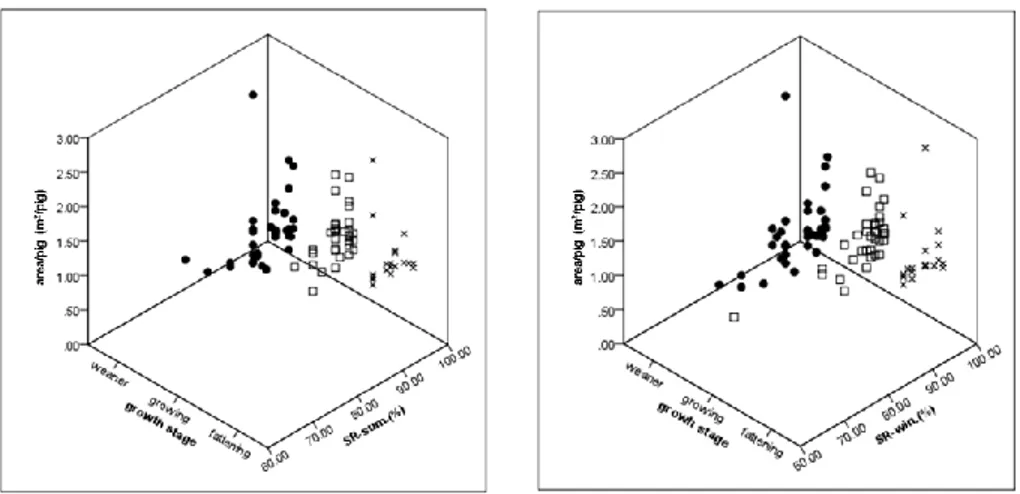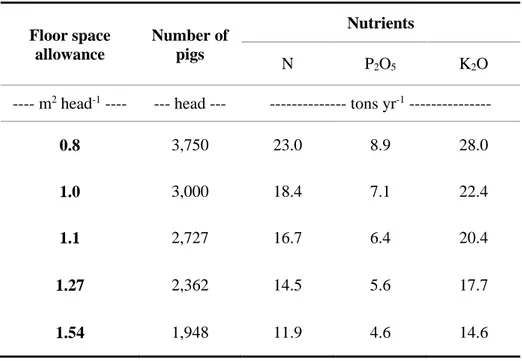저작자표시-비영리-변경금지 2.0 대한민국 이용자는 아래의 조건을 따르는 경우에 한하여 자유롭게 l 이 저작물을 복제, 배포, 전송, 전시, 공연 및 방송할 수 있습니다. 다음과 같은 조건을 따라야 합니다: l 귀하는, 이 저작물의 재이용이나 배포의 경우, 이 저작물에 적용된 이용허락조건 을 명확하게 나타내어야 합니다. l 저작권자로부터 별도의 허가를 받으면 이러한 조건들은 적용되지 않습니다. 저작권법에 따른 이용자의 권리는 위의 내용에 의하여 영향을 받지 않습니다. 이것은 이용허락규약(Legal Code)을 이해하기 쉽게 요약한 것입니다. Disclaimer 저작자표시. 귀하는 원저작자를 표시하여야 합니다. 비영리. 귀하는 이 저작물을 영리 목적으로 이용할 수 없습니다. 변경금지. 귀하는 이 저작물을 개작, 변형 또는 가공할 수 없습니다.
Doctoral Thesis
Flow of Manure Nutrient, Floor
Space Allowance and Nitrogen
Fertilization Practice (Rice
Farming) in Integrated
Crop-Animal Farming System
경축순환농업체계의 가축분뇨 양분흐름,
단위사육면적 및 질소시비법(답작) 분석
July. 2017
Seoul National University Graduate School
Department of Agricultural Biotechnology
Flow of Manure Nutrient, Floor
Space Allowance and Nitrogen
Fertilization Practice (Rice
Farming) in Integrated
Crop-Animal Farming System
Thesis Advisor Professor, Hong L. Choi
Submitting this monograph as a doctoral dissertation
July. 2017
Seoul National University Graduate School
Department of Agricultural Biotechnology
Joonhee Lee
Confirming the doctoral dissertation written by
Joonhee Lee
June. 2017
Chairman (seal)
Vice Chairman (seal)
Committee Member (seal)
Committee Member (seal)
Committee Member (seal)
Abstract
Flow of Manure Nutrient, Floor Space
Allowance and Nitrogen Fertilization
Practice (Rice Farming) in Integrated
Crop-Animal Farming System
Joonhee Lee
Animal Biotechnology
The Graduate School
Seoul National University
An integrated crop-animal farming (ICAF) refers to a management system that establishes a sustainable agricultural environment and ecosystem by reusing the by-products between the livestock farms and the crop farms in the agricultural system. Understanding the balance of nutrients from the generation of livestock manure to the land-application of plant-soil system is considered to be one of the important factors in establishing the ICAF system. However, it is not easy to understand the relationship of each factor and find a balance point because the complex processes are linked in the ICAF system. Therefore, this dissertation analyzed the nutrient flow and dynamics from livestock manure production to land-application in South Korea. The nutrient flow of pig manure in the ICAF system was analyzed by applying appropriate FSA considering pig productivity. In addition, a suitable method of using chemical fertilizer and treated swine slurry was proposed. As a result, the following conclusions were obtained.
First, the ICAF system in South Korea is still inadequate and has been suffering from the disposal of livestock manure and agricultural waste in many areas.
Therefore, it was necessary to closely examine the ICAF status of the relatively active areas (Nonsan and Namwon) and to find out the ICAF system considering the characteristics of the poor ICAF areas (Yeongcheon and Jinju). In Jinju, the urbanization rate was relatively high. Therefore, the ICAF system was considered to be suitable for the two-track model that co-promotes the compost/liquid fertilizer facility and the energy facility. In the case of Yeongcheon, it would be appropriate to install three to four decentralized public recycling facilities at midsize (around 30 tons) in myeon where a cluster of livestock farms was located. However, according to scenario predictions, the recycling rate of livestock manure in the area had increased but the over-supply of nutrients had not decreased. Comparing the nutrient requirement of the crop with the amount of nutrient input to the cropland, it can be seen that 113 kgha-1 of N and 146 kgha-1 of P
2O5 were over-supplied annually. In
Jinju, 12 kg ha-1 yr-1 of P
2O5 was expected to have an oversupply in comparison with
the amount of nutrients required for crops. Even if the ICAF system is built in consideration of local characteristics, the use of large amounts of livestock manure and indiscriminate application of chemical fertilizers exceeding the capacity of agricultural land remains a problem.
Second, the appropriate level of floor space allowance (FSA) is probably the most important factor in managing this large-scale pig farms. In particular, the pig farming industry in South Korea prefer to pursue profit by maximizing the production of pigs in a limited space as much as possible. As a result, farmers (producers) are guaranteed a certain level of productivity, but livestock, farm managers, and people around the farm cannot avoid the negative impact. In this dissertation, the average survival rate (SR) of growing pigs tended to increase with increasing FSA. Generally, fattening pigs in South Korea were being raised in a
small space. Therefore, it was found that if the FSA of “0.8 ~ 1.0 m2 head-1” is
increased to “1.1 ~ 1.27 m2 head-1”, it contributed to raise the average SR. The days
at a slaughter weight of 110 kg (d-SW) of fattening pigs also showed a tendency to decrease with increasing FSA. It is considered that the fattening pigs raised in moderately wide space (1.27 ~ 1.54 m2 head-1) were helpful for the increase of the
growth rate due to the stress reduction. A slight increase in the FSA can have a positive impact on productivity, while also solving environmental problems.As FSA increased, the amount of nutrients (N, P2O5 and K2O) from livestock manure was
reduced. In the case of N, 20%, 27%, 37% and 48% of N were reduced in 1.0 m2 head-1, 1.1 m2 head-1, 1.27 m2 head-1 and 1.54 m2 head-1, respectively, compared to
the N value of 0.8 m2 head-1. Other nutrients (P
2O5 and K2O) were also reduced at a
similar rate. According to the nutrient flow calculation method of the four regions (Namwon, Nonsan, Yeongcheon and Jinju), increasing the FSA from 0.8 to 1.54 m2
head-1 resulted in a reduction of surplus N up to 60%. In the case of P
2O5, 5% ~ 16%
was reduced as the FSA increased, and the deviation by region excluding Jinju was not large. Jinju showed the highest surplus P2O5 reduction (61%) compared to other
regions probably due to the large cropland area per livestock unit (LU).
Third, the use of proper N fertilizer in rice farming is an essential factor in the success of farming. The N fertilization practices using organic fertilizers (livestock manure) with chemical fertilizers are being used as part of sustainable agriculture. When using anaerobically-aerobically treated swine slurry (TSS) and chemical fertilizer (AS) in combination, it is preferable to use the chemical fertilizer less than 3:1 ratio since the recovery of inorganic N was constant regardless of the mixing ratio of AS. In the oxidized topsoil of paddy soils, NH4+ was converted to
δ15N level increased as the 14NH
4+ decreased.Total 15N recovery (crop + soil) was
42%, 43% and 54% in HTSS + LAS (3:1 ratio of TSS and AS), LTSS + HAS (1:2 ratio of TSS and AS) and AS (chemical fertilizer only), respectively. The N fertilization practice with low AS and high TSS rates was recommended for sustainability and cost savings. However, N losses, especially through the coupled nitrification-denitrification process, can diminish the benefits that HTSS+LAS offers.
In the introduction of this dissertation, the current status and problems of the overall livestock production in South Korea were described. In chapter 2, two regions (Yeongcheon and Jinju) operated as individual recycling facilities and two regions operated by public recycling facilities (Namwon and Nonsan) were selected to investigate the dynamics of livestock manure nutrients. The potential nutrient supply and nutrient requirements of crops were analyzed. Chapter 3, in conjunction with the content of Chapter 2, examined the appropriate FSA that satisfies both productive and environmental aspects. Chapter 4 discussed the land-application of livestock manure for the next phase of the livestock manure disposal and treatment process (discussed in chapter 2). The N behavior of paddy soils using TSS + AS mixed fertilization practices was investigated. Conventional land-application studies on livestock manure were based primarily on fertilizer value and crop productivity of compost / liquid fertilizer. This thesis is different in that it can analyze the N behavior of the soil-crop system more accurately by using 15N and proposed
appropriate TSS and AS fertilization practices compared with existing methods. In particular, anaerobically-aerobically treated pig slurry was used as a fertilizer resource in paddy soils. This is a study on the follow-up process of renewable energy of livestock manure and can be regarded as an academic contribution of this thesis. It is hoped that guidelines on the land-application of livestock manure in various
agricultural sectors such as horticulture, upland, fruit trees, grass land as well as paddy soil will be created on the direct / indirect extension of this thesis.
Keywords : Livestock manure, Nutrient flow, Floor space allowance, Integrated crop-animal farming, 15-Nitrogen stable isotope, Treated swine slurry
TABLE OF CONTENTS
ABSTRACT
LIST OF TABLES
LIST OF FIGURES
CHAPTER 1. GENERAL INTRODUCTION ... 1
1.1. Background of research ... 1
1.1.1. Case study: The nitrogen loss through ammonia gas volatilization4 1.1.2. The livestock manure treatment system in South Korea... 10
1.1.3. Effect of livestock manure on soil and water pollution ... 17
1.2. Research objectives ... 22
1.3. Reference ... 23
CHAPTER 2. NUTRIENT FLOW OF LIVESTOCK MANURE IN AN
INTEGRATED CROP-ANIMAL FARMING SYSTEM ... 28
2.1. Abstract ... 28
2.2. Introduction ... 29
2.3. Methods ... 31
2.3.1. Amount of livestock manure ... 35
2.3.2. Recycling status of livestock manure ... 36
2.3.3. Flow analysis of nitrogen, phosphorus, and potassium derived from livestock manure ... 38
2.4. Results and Discussion ... 45
2.4.1. Proposal of ICAF models ... 45
2.4.2. Nitrogen, phosphorus and potassium flow analysis from livestock manure ... 49
2.5. Conclusion ... 62
2.6. Reference ... 64
CHAPTER 3. EFFECT OF FLOOR SPACE ALLOWANCE ON PIG
PRODUCTIVITY AND MANURE NUTRIENTS FLOW ... 66
3.1. Abstract ... 66
3.2. Introduction ... 68
3.3. Materials and methods ... 71
3.3.1. The farm survey ... 71
3.3.2. Pig productivity index, floor space allowance, and estimation of manure nutrient flow ... 72
3.3.3. Statistical analysis ... 72
3.4. Results and Discussion ... 75
3.4.1. Non-productive sow days ... 75
3.4.2. Number of weaners ... 79
3.4.3. Survival rate ... 80
3.4.4. Average appearance rate of A-grade pork ... 83
3.4.5. Days at a slaughter weight of 110 kg ... 84
3.4.6. Effect of floor space allowance on manure nutrients flow in soil-crop system ... 84
3.5. Conclusion ... 90
3.6. Reference ... 92
CHAPTER 4. THE DYNAMICS OF NITROGEN DERIVED FROM A
CHEMICAL NITROGEN FERTILIZER WITH
ANAEROBICALLY-AEROBICALLY TREATED SWINE SLURRY IN PADDY
SOIL-PLANT SYSTEMS ... 97
4.1. Abstract ... 97
4.2. Introduction ... 98
4.3. Materials and methods ... 100
4.3.1. Lysimeter description ... 100
4.3.2. Experimental design ... 104
4.3.3. Application of chemical N fertilizer (15N-labeled ammonium sulfate) with treated swine slurry ... 107
4.3.4. Chemical analysis ... 109
4.3.5. Rice 15N uptake, soil 15N recovery and total 15N recovery calculation ... 112
4.3.6. Statistical analysis ... 113
4.4. Results ... 113
4.4.1. Dry matter yield and total N uptake by rice ... 113
4.4.2. Soil total N, soil nitrate N, ammonium N and total soil 15N recovery ... 114
4.4.3. Nitrogen-15 recoveries in the soil-plant system ... 118
4.5.1. Rice response to the applied N derived from each N fertilization
practice ... 121
4.5.2. The contribution of applied N fertilizer to N turnover in the rice paddy soil with different N fertilization practices ... 122
4.5.3. The fate of 15N derived from a chemical N fertilizer with TSS in paddy soil-plant systems ... 128
4.5.4. Nitrogen loss through runoff and leaching ... 133
4.5.5. Limitations of the research ... 138
4.6. Conclusion ... 139 4.7. Reference ... 142
CHAPTER 5. CONCLUSION ... 148
APPENDIX ... 154
ABSTRACT IN KOREAN ... 159
LIST OF TABLES
Table 1.1. Pork supply and demand status in South Korea ... 2
Table 1.2. Physicochemical characteristics of raw swine slurry and treated
swine slurry (effluent) ... 16
Table 2.1. Date of interview and survey investigation in sampling sites .. 33
Table 2.2. Treatment status of livestock manure at four regions in South
Korea ... 38
Table 2.3. The amount of nutrient (N, P
2O5, K2O) in livestock manure ... 41Table 2.4. Urbanization rates of different four regions (Yeongcheon, Jinju,
Nonsan and Namwon) ... 47
Table 2.5. Livestock manure production by sampling sites ... 51
Table 2.6. Relationship between number of livestock (LU basis) and cropland
area... 52
Table 2.7. Three primary nutrients (N, P
2O5, K2O) production in samplingsites ... 55
Table 2.8. Additional chemical fertilizer requirement (A
x) and excessive Nand P2O5 (Bx) in YC and Jinju site ... 61
Table 3.1. Floor space allowance standard according to the growth stage of
pigs in South Korea ... 70
Table 3.2. Productivity index of pig with the different growth stages ... 74
Table 3.3. The correlation between four different FSAs (VL, L, M, H) and
pig productivity index ... 76
Table 3.4.
Estimation of the amount of nutrients generated by FSA change (based on area of 3,000 m2)... 85
Table 3.5.
Effect of floor space allowance on manure nutrient surplus (N and P2O5)in Namwon, Nonsan, Yeongcheon and Jinju
... 87
Table 4.1. List of treatments and the application rate of nitrogen (N) .... 111
Table 4.2. Soil total nitrogen (TN), soil nitrate N (NO
3-), ammonium N
(NH4
+), and total soil
15N recovery following an application of
15N-labeled
ammonium sulfate and treated swine slurry ... 116
Table 4.3. Linear regression analysis used to describe the predicted influence
of inorganic N form on δ
15N in different soil layers... 119
Table 4.4. Nitrogen-15 recoveries of the labeled N source (ammonium sulfate)
in the different fertilization practices in a paddy soil-plant system ... 120
Table 4.5. Replacement value of chemical fertilizer in livestock manure
nutrients (as of 2016) ... 131
LIST OF FIGURES
Fig 1.1. Number of pig houses and pigs in small-scale farms (<1,000 pigs) in
South Korea from 2010 to 2016 ... 3
Fig 1.2. Number of pig houses and pigs on large-scale farms (over 5,000 pigs)
in South Korea from 2010 to 2016 ... 4
Fig 1.3. First generation pig house type in Korea (winch curtain and scraper
pig house, field survey in 2013) ... 5
Fig 1.4. Second generation pig house type in Korea (open window slurry pit
pig house, field survey in 2013) ... 6
Fig 1.5. Third generation pig house type in Korea (non-circulating enclosed
slurry pit pig house, field survey in 2013) ... 6
Fig 1.6. Ammonia gas concentration (ppm) of pig house (inside) ... 7
Fig 1.7. Flux chamber-Vacuum cabinet: collecting odor samples in compost
using Tedlar bag ... 8
Fig 1.8. Ammonia gas concentration (ppm) of compost process ... 9
Fig 1.9. Livestock manure to energy method: underground anaerobic
digestion system for methane fermentation (AEBE laboratory) ... 11
Fig 1.10. . Public recycling facilities (liquid fertilization, the photographs
were taken in 2012 by the local animal manure field survey in South Korea)
... 12
Fig 1.11. Public recycling facilities (solid fertilization, the photographs were
taken in 2012 by the local animal manure field survey in South Korea) .. 12
Fig 1.12. Individual solid fertilization facilities (the photographs were taken
in 2012 by the local animal manure field survey in South Korea) ... 13
Fig 1.13. Individual liquid fertilization facilities (the photographs were taken
in 2012 by the local animal manure field survey in South Korea) ... 13
Fig 1.14. The livestock manure treatment systems in South Korea ... 14
Fig 1.15. Nitrogen cycle in upland and paddy soil ... 20
Fig 2.1. Data collection through on-site interviews and surveys (Namwon,
Nonsan, Yeoungcheon, Jinju) ... 34
Fig 2.2. Crop cultivation status in Nonsan and Namwon (adapted from
statistical yearbook of 2011). These figures exclude crops with less than 2%
cultivation area. ... 57
Fig 2.3. Crop cultivation status in Yeongcheon and Jinju (adapted from
statistical yearbook of 2011). These figures exclude crops with less than 2%
cultivation area. ... 58
Fig 3.1. The distribution of weaner, growing, and fattening pig’s survival
rate (SR) over floor space allowance (FSA) by season: summer and winter
(: weaner, : growing pigs, ×: fattening pigs). ... 82
Fig 3.2. Effect of floor space allowance on nutrient (N and P
2O5) surplus inNamwon ... 88
Fig 3.3. Effect of floor space allowance on nutrient (N and P
2O5) surplus inNonsan ... 88
Fig 3.4. Effect of floor space allowance on nutrient (N and P
2O5) surplus inYeongcheon ... 89
Fig 3.5. Effect of floor space allowance on nutrient (N and P
2O5) surplus inJinju ... 89
Fig 4.1. Undisturbed soil monolith collection from the field at Suwon SNU
farm, South Korea ... 102
Fig 4.2. Lysimeter design: The leachate drained through the perforated
bottom plate of the lysimeter to mimic natural leaching conditions. ... 103
Fig 4.3. Experimental layout: A randomized complete block design; the main
plots consisted of three replicates. The main plots were divided into four
subplots corresponding to the four treatments (HTSS+LAS, LTSS+HAS, AS,
and C). ... 105
Fig 4.4. Relative humidity (dashed-line) and temperatures (solid-line) at the
livestock experimental farm in Suwon, South Korea during the 2014
experimental period. The open arrow indicates the rainfall date using a
simulator. To prevent the rainfall simulator from freezing, a heater was used
at the experimental site on December 11 ... 106
Fig 4.5. Treated swine slurry production process: subsequent treatment
process after UGAD and BWWT system ... 108
Fig 4.6. Biomass (dry matter) yield (a) and Total N uptake by rice after
application of treated swine slurry and chemical fertilizer (b). Error bars
represent standard deviations (n=3) of the means of rice biomass yield
(combined value of grain and stem) and total N uptake by rice (combined
value of grain and stem) ... 115
Fig 4.7.
Correlation analysis of soil NO3-, NH4+ and δ15N values in 0-5 cm soil layer... 124
Fig 4.8.
Correlation analysis of soil NO3-, NH4+ and δ15N values in 5-10 cm soillayer
... 125
Fig 4.9.
Correlation analysis of soil NO3-, NH4+ and δ15N values in 10-20 cm soillayer
... 125
Fig 4.10.
Correlation analysis of soil NO3-, NH4+ and δ15N values in 20-30 cm soillayer
... 126
Fig 4.11. Correlation analysis of soil NO
3-, NH4
+and δ
15N values in HTSS +
LAS treatment ... 127
Fig 4.12. Correlation analysis of soil NO
3-, NH4
+and δ
15N values in LTSS +
HAS treatment ... 127
Fig 4.13. Correlation analysis of soil NO
3-, NH4
+and δ
15N values in AS
treatment ... 128
Fig 4.14. The soil pH of each N fertilization practice after harvest ... 130
Fig 4.15. Soil
15N recovery (a) and soil δ
15N (b) after an application of treated
swine slurry and chemical fertilizer. Error bars represent standard deviations
(n=3) of the means of soil
15N recovery and soil δ
15N, respectively ... 132
Fig 4.16. Cumulative Total N loss from runoff and leaching. Three rainfall
events (June 03, August 10 and September 21) with moderate intensity (9.0
mm hr
-1) were applied during the experimental period. Error bars represent
standard deviations (n=3) of the means of total N in the water sample .. 135
Fig 4.17. Proportion of total N loss (%) in runoff and leaching processes136
Fig 4.18. Cation exchange capacity (CEC) of each N fertilization practice
... 137
Fig 4.19. The electrical conductivity (EC) of each N fertilization practice
... 138
Fig 5.1. The logical flow chart of each thesis's chapters ... 149
CHAPTER 1. GENERAL INTRODUCTION
1.1. Background of research
Reliance on livestock to satisfy human demand for animal products is increasingly high. For producers, concentrated animal feeding operation (CAFO) is a cost-effective way to meet the increasing demand for animal products due to population growth. This production system is also good for consumers because consumers can easily purchase the right-price livestock products from the market. As long as there is no complaint, the current system will be maintained. However, concerns are growing about CAFO as the immorality of the system and the consumption trend requiring a healthy diet became widely known to the public through the media. Especially, South Korea has limited land area to operate the livestock industry. Therefore, the approach from the environmental aspect is emphasized unlike European animal welfare approach (Hovi et al., 2003; Borell and Sørensen, 2004; Chung et al., 2014). As a national consumption of livestock products increases along with meat intake (Table 1.1), the scale of domestic animal farming also increases, simultaneously increasing the amount of livestock manure.
Table 1.1. Pork supply and demand status in South Korea① Item 2008 2009 2010 2011 2012 2013 2014 2015 Supply Self-production (1,000 tons) 709 722 764 574 750 853 830 842 Importation (1,000 tons) 509 479 524 370 275 185 274 358 Total (1,000 tons) 1,218 1,201 1,288 944 1,025 1,038 1,104 1,200 Demand (1,000 tons) 927 916 940 938 926 1,048 1,118 1,205
Total consumption (1,000 tons) 927 916 940 938 926 1,048 1,118 1,205
Self-sufficiency ratio (%) 58.2 60.1 59.3 60.8 73.2 82.2 75.2 70.2
Per capita consumption (kg) 19.1 19.1 19.2 19.0 19.2 20.9 21.8 23.7
In South Korea, livestock manure generated from swine houses is a particularly serious problem compared to other animal species. Swine manure is higher in water content than the manure of other animals. Of course, water content varies with stages of growth, feed materials, breeding management and manure management② but the water content of swine manure is generally at least 96%,
while the remaining 4% is composed of solids (MWPS-18, 2004; Suresh, 2009).
Fig 1.1. Number of pig houses and pigs in small-scale farms (<1,000 pigs) in
South Korea from 2010 to 2016
The number of small-scale pig farms under 1,000 is showing a decreasing trend in South Korea (Fig 1.1). Small-scale farms cannot properly control the generation of odors, which makes them subject to complaints (a more detailed
② In South Korea, the manure management of pigs is generally accomplished by
collecting feces and urine into slurry pits and then treating them by solid-liquid separation process. Therefore, according to the handling system of the manure, pig manure is a slurry type and has a high moisture content. Beef cattle use bedding materials, which results in lower water content and higher solids content (Source: Ohio State University Extension Bulletin 604, 1992 Edition.).
in case study 1.1.1). The economic difficulties of small-scale farms also make it impossible to invest in improving the farm environment. On the other hand, large-scale farms tend to increase (Fig 1.2). If a large quantity of swine slurry is generated in a confined space, the capacity of the area can easily be exceeded. This causes soil and water pollution, which leads to civil complaints by the residents and even evasion of pig farming in the long term.
Fig 1.2. Number of pig houses and pigs on large-scale farms (over 5,000 pigs)
in South Korea from 2010 to 2016
1.1.1. Case study: The nitrogen loss through ammonia gas volatilization A total of 12 pig houses in South Korea were investigated twice in summer and winter season. The first field survey was conducted in January ~ February 2013, and the second field survey was conducted in July ~ August. In this case study, the above-mentioned small-scale farms were investigated for the status of odor production. Based on the field survey, the type of pig house
was classified as follows: a winch curtain and scraper system for the first-generation pig house (Fig 1.3), an open window slurry pit system for the second-generation pig house (Fig 1.4), and a non-circulating enclosed slurry pit system for the third-generation pig house (Fig 1.5). Odor-causing pig houses including 1st, 2nd and 3rd generation have been faced with realistic operational
limitations. Most municipalities are not allowed to build or renovate swine farms due to odor problem. Recently, a circulating enclosed slurry pit pig house③ (a non-discharge system that recirculates all the generated pig manure
into a pig house) has been developed and popularized. This pig house has the advantage of being capable of structurally reducing odor and producing good quality liquid fertilizer. The produced liquid fertilizer can be used as fertilizer in nearby cropland. Large-scale farms with more than 3,000 pigs showed a tendency to introduce a circulating enclosed slurry pit pig house (a fourth-generation pig house) in South Korea.
Fig 1.3. First generation pig house type in Korea (winch curtain and scraper
pig house, field survey in 2013)
③ Korea Pork Producers Association recommended ‘a circulating enclosed slurry pit
pig house’ as a pig house system capable of reducing odor in the 'Results of product and facility verification of odor reduction in pig farm in 2016' report.
Fig 1.4. Second generation pig house type in Korea (open window slurry pit
pig house, field survey in 2013)
Fig 1.5. Third generation pig house type in Korea (non-circulating enclosed
slurry pit pig house, field survey in 2013)
Ammonia analysis in the pig house showed the highest value in farm #6, followed by farm #9 and farm #2 (Fig 1.6). Sampling was performed by dividing the inner corridor of the pig house into front, middle, and back. Each sample was repeated twice to obtain an average value. Ammonia levels in the pig house of Farm #6 ranged from 20 to 30 ppm, which indicates that the ventilation was poor. In fact, farm #6’s ventilation system was the winch curtain type, but it was not fully opened and was found to rely more on forced ventilation by the fan. It is considered that the ammonia gas generated from the inside was not discharged out due to the structural problem of the pig house. This situation could be interpreted in two ways. One is that inadequate ventilation of the fan prevented air in the pig house from exhausting smoothly
through the winch curtain. Conversely, the air was exhausted directly through the vent without circulating inside the pig house due to excessive fan ventilation.
Fig 1.6. Ammonia gas concentration (ppm) of pig house (inside)
For farm #9, the ammonia level was the second highest at 20 to 25 ppm, and structural problems similar to farm #6 were found. Farm #9 was a winch curtain type pig house. Compared to other pig houses, the farm #9 had relatively old facilities. The pig house was located in the mountains and the temperature difference between day and night was severe. Thus, the one side wall was completely closed despite the winch curtain type. This was the farm owner’s decision to reduce temperature-caused mortality rather than ventilation. It is necessary to find the appropriate point of ventilation and temperature considering the geographical characteristics of the pig house. The N loss via volatilization may also depend on the floor type of the pig house. Slat floor and sawdust floor showed N loss of 25% and 50%, respectively. At the storage process, about 10% additional N loss was observed (Rotz, 2004). Stone et al. (1975) reported that total N (TN) was not significantly affected, although about
0 5 10 15 20 25 30 35 1 2 3 Co ncent ra tio n o f NH 3 (pp m )
3 sampling points of the pig house (inside)
farm #2 farm #3 farm #6 farm #7 farm #9 farm #11
35% of ammonium N was lost under constant temperature and humidity conditions. Other study showed that 47-77% of the initial N was volatilized as ammonia gas and a small amount (<5%) of N was volatilized as NOx gas (Martins and Dewes, 1992). Sommer (2001) reported that about 28% N loss occurred in the composting process of livestock manure. It is reported that the amount of TN was not changed even though N was volatilized by ammonia gas, because organic matter in compost was decomposed for a certain period to supply N (Seo, 1988). The concentrations of volatile ammonia gas in composting process were analyzed at nine livestock manure recycling facilities (S1~S9) located in four cities of Nonsan, Namwon, Yeongcheon and Jinju. Ammonia gas volatilized from the compost pile or stack of compost pile with mechanical agitation was sampled using air sampler, vacuum cabinet, flux chamber and Tedlar bag. The flux chamber was placed on the compost pile and the volatilized air was collected for 20 minutes. Vacuum pump was used to collect the gas that was fed into the Tedlar bag of the connected vacuum chamber at a rate of 2 ml L-1 (Fig 1.7).
Fig 1.7. Flux chamber-Vacuum cabinet: collecting odor samples in compost
Ammonia levels in the composting facilities ranged from 4 to 420 ppm (Fig
1.8). This value was lower than the maximum ammonia concentration of 1,000
ppm produced by pig manure composting reported by Kuroda et al. (1996) and was lower than the highest ammonia concentration of 2,500 ppm produced by chicken manure composting reported by Tanaka et al. (1983). S2 showed the highest ammonia concentration, which is the result of the structural causes of the compost facility. S2 was the only compost facility that was closed and operated by mechanical stirring.
Fig 1.8. Ammonia gas concentration (ppm) of compost process
The volatilization of ammonia gas occurs when ammonium N contained in livestock manure is converted by the following reaction (Meisinger and Jokela, 2000).
Reaction 1: 𝐶𝑂(𝑁𝐻2)2+ 𝐻++ 2𝐻
2𝑂 → 2𝑁𝐻4++ 𝐻𝐶𝑂3−
Reaction 2: 𝑁𝐻4+↔ 𝑁𝐻
3 𝑔𝑎𝑠+ 𝐻+
Urea [CO(NH2)2] is converted to ammonium N via hydrolysis in the presence
8 420 167 82 197 50 60 122 4 50 100 150 200 250 300 350 400 450 S1 S2 S3 S4 S5 S6 S7 S8 S9 Co ncent ra teio n o f NH 3 g a s (pp m ) Composting sites
of water and urease. Ammonia gas can easily be generated inside and outside of the pig house by the above reactions. Thus, small-scale pig farms tend to abandon their farm operations because they are generally unable to control odor complaints and treat pig manure appropriately. This circumstance makes large-scale pig farms (CAFOs) to survive because they can operate expensive odor reduction facilities and swine slurry treatment systems. However, if the farm is not properly managed, CAFOs can also cause severe ammonia gas production because of the high stocking density of animals. In addition, the high amount of swine slurry production from the CAFOs are not easy to recycle as fertilizer due to physical factor (limited land area) and social factor (distrust of liquid fertilizer performance). Various livestock manure treatment systems have been tried in South Korea to solve these problems.
1.1.2. The livestock manure treatment system in South Korea
Swine manure treatment methods can be roughly divided into solid fertilization, liquid fertilization, and waste-to-energy by methane fermentation (Fig 1.9). Solid and liquid fertilization act as a plant nutrient source and soil conditioner by returning to the soil, while the waste-to-energy method has the ability to convert waste from livestock manure into a thermal or electrical energy source. It is necessary to choose the appropriate method according to local conditions and circumstances (To be discussed in detail in Chapter 2).
Fig 1.9. Livestock manure to energy method: underground anaerobic
digestion system for methane fermentation (AEBE laboratory)
Recently, various government departments are supporting a budget for obtaining energy sources using biomass to secure renewable energy④. In this
regard, a bio-energy production system using only livestock manure is not economically feasible. It also can cause a problem of disposal of the waste generated from methane fermentation. Therefore, simply imitating developed countries can be an economical and environmental burden because South Korea imports most organic resources from overseas (Kang and Han, 2013). The government policy for promoting the use of liquid fertilizers is currently expanding the areas where spray the liquid fertilizers. Though the domestic livestock manure treatment methods in practice vary by region, they generally consist of four systems, including public recycling facilities (Fig 1.10 and Fig
1.11), individual compost (Fig 1.12) and liquid fertilization facilities (Fig 1.13),
④ The Ministry of Environment and the Ministry of Agriculture and Forestry are
interested in renewable energy projects using organic waste resources such as livestock manure. The list of research projects is as follows: Ministry of Environment. ‘A study on bioenergy recovery and composting technique for pig slurry’. Korea Environmental Industry & Technology Institute. 2014; Rural Development Administration. ‘Recovery of bioenergy from renewable animal and food waste’. National Institute of Agricultural Science. 2009.
public treatment facilities, and individual purification treatment facilities. Livestock manure that is brought to public recycling facilities or individual compost and liquid fertilization facilities is converted to liquid and solid fertilizers (composts) through the recycling process after solid-liquid separation. After that, the liquid fertilizer and compost are returned to the cropland in each region, along with chemical fertilizers. On the other hand, livestock manure that is brought to public treatment facilities or individual purification treatment facilities is discharged into a water system (Fig 1.14).
Fig 1.10. Public recycling facilities (liquid fertilization, the photographs were
taken in 2012 by the local animal manure field survey in South Korea)
Fig 1.11. Public recycling facilities (solid fertilization, the photographs were
Fig 1.12. Individual solid fertilization facilities (the photographs were taken in
2012 by the local animal manure field survey in South Korea)
Fig 1.13. Individual liquid fertilization facilities (the photographs were taken
Liquid fertilizers have been used with chemical fertilizers for cultivation of rice, vegetable crops, fruit trees, and grass in South Korea. However, there are still negative opinions in the field because of the lack of review of an accurate analysis of soil, nutrient requirements of vegetation, fertilizer application level according to component analysis of liquid fertilizers, and spraying facilities and methods (RDA, 2010). The TS (total solids) and TVS (total volatile solids) values of raw swine slurry were different (Table 1.2). The TN of the raw swine slurry was not significantly different from 3.8 to 5.4 g kg-1. The pH was in the
range of 7.2 ~ 7.9, which is neutral or weakly alkaline. The TS and TVS values of the effluent after biological treatment (aerobic or anaerobic treatment) were significantly reduced. The TP (total phosphorus) and TN values were also reduced. The pH of swine slurry after treatment was not largely changed. However, the pH was changed to slightly acidic (pH 5.2) according to the treatment method (coupled with aerobic and anaerobic process). Solid fertilization is a way to add bulking agents like sawdust and chaff (rice husk) to livestock manure with high water content (RDA, 2010). The livestock manure mixed with bulking agents is fermented for some time to decompose organic matter. The amount of water is adjusted through the process of adequate composting before finally returning it to the soil. Recently, some solid fertilizers did harm the crops and caused an odor due to nutrient component shortage and immature compost.
Table 1.2. Physicochemical characteristics of raw swine slurry and treated swine slurry (effluent) Total solids (TS) Total volatile solids (TVS) Total phosphorus (TP) Total nitrogen (TN) pH Treatment Reference --- g kg-1 --- Raw slurry
53 36 1.5 4.4 7.9 - Melse and Verdoes,
2005
45 32 3.4 5.4 7.4 - Suresh et al., 2008
40 28 2.8 4.6 7.2 - Suresh and Choi, 2011
52 39 - 3.8 - - Boopathy, 1998
25 19 1.8 4.1 7.7 - In this study
Effluent
9 3 0.03 0.41 8.2 Nitrification and
denitrification
Melse and Verdoes, 2005
8 - 0.3 1.7 7.4 Anaerobic digestion Zhu et al., 2009
16 7 - 1.9 7.1 Anaerobic digestion Boopathy, 1998
16 9 0.9 0.7 5.2 Anaerobic/aerobic
As it is difficult to secure adequate bulking agents in particular, the government's efforts are required to secure an adequate amount of bulking agents from overseas (Kang and Han, 2013). Previous study⑤ reported that not
a lot of solid and liquid fertilizers can be additionally returned to soil in respect of the nutrient quota system, because an excessive amount of N and P is stored in the soil in Korea (Song et al., 2012). The land-application of livestock manure should be broadly approached as a whole, considering the expansion of self-sufficiency rate of food, conservation of soil environment, environment-friendly utilization of organic waste generated in South Korea. Conversion of the nutrient supply plan for the soil from the regional concept to the national concept is expected to increase the demand for livestock manure recycling considerably.
1.1.3. Effects of livestock manure on soil and water pollution
There are problems to be solved in order to operate the integrated crop-animal farming (ICAF) system. First, the production of livestock manure exceeds the capacity of cropland (Kim et al., 2015). This means that even if livestock manure is converted to a fertilizer source through a treatment facility, there is a shortage of available agricultural land. Second, Korea has a large regional variation in livestock manure production due to regional biases of livestock farms (Kim et al., 2015). Third, there is a difference in perception of livestock manure between livestock farmers and crop farmers. Because of the
⑤ Directions for introducing total maximum nutrient loading system of cultivated
lack of awareness of the fertilizer value of liquid manure, it is difficult to find crop farmers that can use liquid fertilizers (Song et al., 2012). The amount of livestock manure was only 1% of the total sewage and wastewater production, but the water pollution load accounted for 37.0% (Ministry of Environment, 2012). The proportion of livestock and soil contributing to nonpoint pollutants (BOD and TP basis) was 91% to 95% (Jang, 2013). Due to the aforementioned problems, livestock manure is more likely to act as an environmental pollutant source than a fertilizer source (Brennan et al., 2012; O’ Flynn et al., 2013; Laurenson and Houlbrooke, 2014).
Especially, liquid fertilizer derived from pig manure has a high potential to cause environmental pollution due to lack of use area (agricultural land). The concentration of N in the liquid fertilizer varies greatly depending on the treatment process and raw manure composition (Table 1.2). Therefore, liquid fertilizer is used on agricultural land by estimating the fertilizer rate based on N (RDA, 2010). In other words, the N concentration analysis is necessary before using liquid fertilizer (Laboski et al., 2006). If the N analysis is neglected, the possibility of accumulation of nutrients in soil (Steinfeld et al., 2006; Liu et al., 2012; Kumaragamage et al., 2016) and possibility of water pollution (Kim et al., 2013; King et al., 2017) becomes high. In general, surplus N is lost through leaching and run-off from cropland (Oenema et al., 2007; Sommer et al., 2013). Oenema et al. (2007) reported that about 4% of the N excreted in barns was lost via leaching and run-off. Tabbara (2003) reported that the compost and liquid fertilizer runoff from agricultural lands depends mainly on rainfall and cropping conditions (i.e., cropping system, fertilizer rate,
water management, soil management, etc.). The extent of runoff is determined by precipitation and rainfall intensity (Shepherd et al., 2012; Wallace et al., 2013).
The rainfall in Korea tends to be concentrated between June in early summer and early September. If the amount of precipitation exceeds the potential evapotranspiration, the run-off water occurs. In other periods, irrigation is needed due to lack of water. It is important to manage the compost and liquid fertilizer efflux that take into account these non-periodic, intermittent and short-term rainfall characteristics. Soil erosion occurs due to high rainfall intensity, and the soil particles flow into the water system. The soil particles which include livestock manure nutrient cause runoff along with soil loss on the surface (Sommer et al., 2013). On the other hand, leaching is a process in which nutrients escape through pores in the soil with the water flow (Fig. 1.15). Studies on the effects of these factors (weather conditions, crops species, cultivation conditions, soil characteristics etc.) on the dynamics of fertilizer components (mainly N and P) and their quantification are insufficient in South Korea.
Fig 1.15. Nitrogen cycle in upland and paddy soil ⑥
⑥ Adapted from Bijay-Singh, Singh VK. Rice Production Worldwide: Chapter 10. Fertilizer management in rice. Springer. Pp. 217-253;
Although most of the processed livestock manure is returned to cropland through the recycling process, it still contains many problems such as odor emission, incorrect use, lack of social awareness of liquid fertilizer, improper treatment, soil and water pollution. Therefore, this dissertation analyzed the nutrient flow from livestock manure production to land-application in South Korea. Understanding the balance of nutrients from the generation of livestock manure to the land-application of soil-crop system is considered to be one of the important factors in establishing the ICAF system. In chapter 2, two regions (Yeongcheon and Jinju) operated as individual recycling facilities and two regions operated by public recycling facilities (Namwon and Nonsan) were selected to investigate the dynamics of livestock manure nutrients. The potential nutrient supply and nutrient requirements of crops were analyzed. In chapter 3, the appropriate pig’s floor space allowance (FSA) in terms of productivity was examined in conjunction with the livestock manure environmental problems mentioned in chapter 2. Chapter 4 discussed the land-application of livestock manure (treated swine slurry) for the next phase of the livestock manure disposal and treatment process (discussed in chapter 2). A well-managed chemical N fertilization practice combined with anaerobically-aerobically treated swine slurry (TSS) is necessary to improve sustainability and N use efficiency in rice farming. Therefore, the dynamics of N derived from chemical N fertilizer with and without TSS in paddy soil-plant systems were investigated.
1.2. Research objectives
The objectives of this study were:
1. To analyze the nutrient flow based on an analysis of the relationship between the potential nutrient supply and the nutrient requirement for crops when livestock manure is returned to cropland
2. To determine the effect of FSA on pig productivity and performance, and to evaluate the nutrient flow of livestock manure in soil-crop systems based on the proposed FSA
3. To estimate the contribution of applied fertilizer N to the N turnover in the rice paddy soil with different N fertilization practices that are manipulated by the quantity of anaerobically-aerobically treated swine slurry and chemical N fertilizer
4. To compare the rice response to the applied N derived from each of N fertilization practices
1.3. Reference
Boopathy R. Biological treatment of swine waste using anaerobic baffled reactors. Bioresource Technol. 1998; 64: 1-6.
Borell EV, Sørensen JT. Organic livestock production in Europe: aims, rules and trends with special emphasis on animal health and welfare. Livest Prod Sci. 2004; 90: 3-9.
Brennan RB, Healy MG, Grant J, Ibrahim TG, Fenton O. Incidental phosphorus and nitrogen loss from grassland plots receiving chemically amended dairy cattle slurry. Sci Total Environ. 2012; 441: 132-140.
Chung SH, Lee JS, Kim MJ, Lee HG. The development status and prospect of Korean livestock industry. J Anim Vet Adv. 2014; 13: 1143-1149.
Hovi M, Sundrum A, Thamsborg SM. Animal health and welfare in organic livestock production in Europe: current state and future challenges. Livest Prod Sci. 2003; 80: 41-53.
Jang JR. Agricultural non-point pollution, alternatives to water quality
management. RRI focus. 2013; 18: 1-24.
http://rri.ekr.or.kr/cop/bbs/selectBoardList.do?bbsId=BBSMSTR_00000000 0032.
Kang CY, Han HS. Issues on distribution and use of organic fertilizers and improvement measures. Korea Rural Economic Institute. 2013; 1-160.
Kim MK, Kwon SI, Chun HC, Jung GB, Kang KK. Impacts of pig manure-based liquid fertilizer agricultural application on the water quality of agricultural catchment. J Environ Prot. 2013; 4: 195-200.
Kim CG, Jeong HK, Im PE, Kim TH. Directions for introducing total maximum nutrient loading system of cultivated land. Korea Rural Economic Institute. 2015. C2015-5.
King T, Schoenau J, Elliott J. Relationship between manure management application practices and phosphorus and nitrogen export in snowmelt run-off water from a Black Chernozem Saskatchewan soil. Sustainable Agriculture Research. 2017; 6: 93-114.
Kumaragamage D, Akinreml OO, Racz GJ. Comparison of nutrient and metal loadings with the application of swine manure slurries and their liquid separates to soils. J Environ Qual. 2016; 45: 1769-1775.
Kuroda K, Osada T, Yonaga M, Kenematu A, Nitta T, Mouri S, et al. Emissions of malodorous compounds and greenhouse gases from composting swine feces. Bioresource Technol. 1996; 56: 265~271.
Laboski CAM, Peters JB. Bundy LG. Nutrient application guidelines for filed, vegetable, and fruit crops in Wisconsin. UW-Extension. 2006; A2809: 1-76.
Laurenson S, Houlbrooke DJ. Nutrient and microbial loss in relation to timing of rainfall following surface application of dairy farm manure slurries to pasture. Soil Research. 2014; 52: 513-520.
Liu J, Aronsson H, Ulén B, Bergström L. Potential phosphorus leaching from sandy topsoils with different fertilizer histories before and after application of pig slurry. Soil Use and Management. 2012; 28: 457-467.
Meisinger JJ, Jokela WE. Ammonia volatilization from dairy and poultry manure. Pages 334-354 in Managing, nutrients and pathogens from animal agriculture. NRAES-130, Natural Resource, Agriculture, and Engineering Serive, Ithaca, NY.
Melse RW, Verdoes N. Evaluation of four farm-scale systems for the treatment of liquid pig manure. Biosyst Eng. 2005; 92: 47-57.
Ministry of Environment. Comprehensive Measures to Advance Management of Livestock Manure. 2012.
MWPS-18. Section 1. Manure Characteristics. MidWest Plan Service, Iowa State University, Ames, Iowa 50011-3080. 2004; 1-24.
Oenema O, Oudendag D, Velthof GL. Nutrient losses from manure management in European Union. Livest Sci. 2007; 112: 261-272.
O’ Flynn CJ, Healy MG, Wilson P, Hoekstra NJ, Troy SM, Fenton O. Chemical amendment of pig slurry: control of runoff related risks due to episodic rainfall events up to 48 h after application. Environ Sci Pollut Res. 2013; 20: 6019-6027.
RDA. 2010. Manual for Livestock Manure Composting / liquid fertilizer utilization technology. Publication registration number:
11-1390000-002801-01.
RDA. 2016. Agricultural Business Management Assistant: Pig management. 11-1390000-004022-01.
Rotz CA. Management to reduce nitrogen losses in animal production. J Anim Sci. 2004; 82: 119-137.
Seo JY. Changes of Chemical Compounds in Compost of Municipal Refuse. Korea J Environ. Agric. 1988; 7: 146-152.
Shepherd M, Wyatt J, Welten B. Effect of soil type and rainfall on dicyandiamide concentrations in drainage from lysimeters. Soil Res. 2012; 50: 67-75.
Sommer SG. Effect of composting on nutrient loss and nitrogen availability of cattle deep litter. Europ J Agronomy. 2001; 14: 123-133.
Sommer SG, Christensen ML, Schmidt T, Jensen LS. Animal manure recycling: treatment and management. John Wiley & Sons, Ltd. 2013.
Song WJ, Kim YH, Lee YG. Study on optimum distribution and use of livestock manure in each region. Korean Journal of Agricultural Management and Policy. 2012; 39: 889-909.
Stone ML, Harper JM, Hansen RW. 1975. Decomposition rates of beef cattle wastes. Managing livestock wastes P. 344-346. In proc. 3rd Int. Symp. On Livestock Wastes, Urbana-Champaign, IL.
Steinfeld H, Gerber P, Wassenaar T, Castel V, Rosales M, de Haan C.
Livestock’s long shadow: environmental issues and options. FAO, Rome, 2006.
Suresh A, Choi HL, Oh DI, Moon OK. Prediction of the nutrients value and biochemical characteristics of swine slurry by measurement of EC – Electrical conductivity. Bioresource Technol. 2009; 100: 4683-4689.
Suresh A, Choi HL, Lee JH, Zhu K, Yao HQ, Choi HJ, et al. Swine slurry characterization and prediction equations for nutrients on South Korean Farms. Transactions of the ASABE. 2008; 52: 267-273.
Suresh A, Choi HL. Estimation of nutrients and organic matter in Korea swine slurry using multiple regression analysis of physical and chemical properties. Bioresource Technol. 2011; 102: 8848-8859.
Tabbara H. Phosphorus loss to runoff water twenty-four hours after application of liquid swine manure or fertilizer. J Environ Qual. 2003; 32: 1044-1052. Tanaka H, Haga K, Yonaga M, Nakajima K. “Control of malodors from swine
feces on composting.” Proceedings of New Strategies for Improving Animal Production for Human Welfare - The Fifth World Conference on Animal Production. Tokyo. Japanese Society of Zootechnical Science. 1983; 2: 835~837.
Wallace CB, Burton MG, Hefner SG, DeWitt TA. Effect of preceding rainfall on sediment, nutrients, and bacteria in runoff from biosolids and mineral fertilizer applied to a hayfield in a mountainous region. Agr Water Manage. 2013; 130: 113-118.
Zhu K, Choi HL, Yao HQ, Suresh A, Oh DI. Effects of anaerobically digested pig slurry application on runoff and leachate. Chem Ecol. 2009; 25: 359-369.
CHAPTER 2. NUTRIENT FLOW OF
LIVESTOCK MANURE IN AN INTEGRATED
CROP-ANIMAL FARMING SYSTEM
2.1. Abstract
An integrated crop-animal farming (ICAF) system has emerged as a sustainable agricultural system that recognizes livestock manure from livestock farming as a fertilizer resource and returns it to cropland. However, the ICAF system in South Korea has not been universalized, and it is easy to find regions that have difficulties in processing and recycling livestock manure. The objectives of this study were (1) to suggest the customized ICAF system reflecting the regional characteristics and (2) to analyze the livestock manure nutrients flow in terms of three primary elements as N, P, and K. The field investigation and survey were conducted from June to September of 2012. The field investigation and interview involved a total of twelve recycling facilities, including two in Nonsan, three in Namwon, three in Yeongcheon and four in Jinju. The questionnaire consisted of 54 farms in Namwon, 51 farms in Yeongcheon, and 44 farms in Jinju. Nonsan was not surveyed. The mass balance analysis was used to suggest and evaluate the ICAF systems for two sites (Jinju and Yeongcheon). Jinju’s public recycling facilities were expected to be more effective as a ‘two - track model’ as well as a role of compost/liquid fertilizer processes. In the case of Yeongcheon, it would be appropriate to install three to four decentralized public recycling facilities at midsize (around 30 tons) in myeon where a cluster of livestock farms was located. Comparing the nutrient flow of the scenarios where the public recycling facilities were
applied to the existing treatment, it was found that N, P2O5 and K2O did not
differ greatly before and after applying the model in Jinju. This was the result of the high recycling rate of livestock manure (98%) in Jinju. In Yeongcheon where the ICAF model was applied, N, P2O5, and K2O were generated from
livestock manure in a similar amount as well. The N, P2O5 and K2O values of
Yeongcheon after applying the model increased by 3.2%, 1.1% and 3.9%, respectively. However, comparing the nutrient requirement of the crop with the amount of nutrient input to the cropland, it can be seen that 113 kgha-1 of N and
146 kgha-1 of P
2O5 were over-supplied annually. In Jinju, 12 kg ha-1 yr-1 of P2O5
was expected to have an oversupply in comparison with the amount of nutrients required for crops. Since Jinju and Yeongcheon may cause eutrophication problems, P2O5 supply should be considered as an essential factor in building
ICAF system.
Keywords: Integrated crop-animal farming, nutrient mass balance, compost,
liquid fertilizer
2.2. Introduction
The resource recycling system, which uses livestock manure generated from animal farms as a fertilizer resource of cropland, that is to say the integrated crop–livestock farming (ICAF) system, has emerged as a key factor for sustainable agriculture (Peyraud et al., 2014). Various ICAF systems from farm level to regional level are considered a way to solve problems like environmental pollution (Bell et al., 2014), biodiversity loss (Lemaire et al., 2014), and nutritional imbalance (Lemaire et al., 2014) resulting from animal
farming practices. Because the ICAF systems in South Korea are in poor condition, there are many regions which have trouble in treating and recycling livestock manure. It is necessary to find appropriate plans and models according to regional characteristics by understanding the status of domestic ICAF system. A thorough examination of the ICAF systems of regions which are relatively poor is also required. Though the domestic livestock manure treatment methods in practice vary with region, they generally consist of four components, including public recycling facilities, individual compost and liquid fertilization facilities, public treatment facilities, and individual purification treatment facilities (RDA, 2010). Livestock manure that is brought to public recycling facilities or individual compost and liquid fertilization facilities is converted to liquid and solid fertilizers (composts) through the recycling process after solid-liquid separation.
After this process, the liquid fertilizer and compost are sprayed on cropland in each region, along with chemical fertilizers. On the other hand, livestock manure that is brought to public treatment facilities or individual purification treatment facilities is discharged into rivers. It is important to trace the flow of the nutrients (N, P, K) derived from composts, liquid fertilizers and chemical fertilizers to make chemical fertilizers more environmentally and economically efficient and recycle the components of fertilizers by returning them to cropland. More specifically, it is necessary to understand the characteristics of livestock manure generation based on the field survey data and the status of treatment facilities. Quantitative interpretation of the inflows, outflows and crop uptake processes of N, P and K originated from treated
livestock manure is a necessary process for proper use of livestock manure as a fertilizer in cropland (Powell et al., 2005). Therefore, this study was designed to (1) propose a customized ICAF model that considers regional characteristics and (2) analyze the nutrient flow related to the proposed models based on an analysis of the relationship between the potential nutrient supply and the nutrient requirement for crops when livestock manure is returned to cropland.
2.3. Methods
For this study, two regions (Yeongcheon and Jinju) that implement ICAF system at their own facilities and two regions (Namwon and Nonsan) that entrust the treatment to public recycling facilities were selected to activate the ICAF system through comparative analysis of the current status of these areas. Interviews were conducted targeting agricultural and livestock farms to investigate and analyze the human, social, and economic aspects related to ICAF system by using a questionnaire survey which was intended to understand how the farmers were aware of the system. Interviewers gave a full explanation to interviewees to make them understand the purpose of the survey and interviewees answered individually in order. First, the interviewer obtained an interviewee’s consent for a face-to-face survey (Fig 2.1). For consistency, orientation was given to participants to explain details about the intent, purpose, and process of the survey. Regions which participated in the interview and survey are listed in Table 2.1. The field investigation and survey were conducted from June to September of 2012. The field investigation and interview involved a total of twelve recycling facilities, including two in
Nonsan, three in Namwon, three in Yeongcheon and four in Jinju. The questionnaire consisted of 54 farms in Namwon, 51 farms in Yeongcheon, and 44 farms in Jinju. In the case of Nonsan, two field investigations (interview) without survey were conducted.
Table 2.1. Date of interview and survey investigation in sampling sites
Site Farms and recycling facilities Type of research Date Nonsan Facility 1 Interview 2012.07.03. Facility 2 Interview 2012.07.03. No livestock farms
and crop farms - -
Namwon
Facility 3 Interview 2012.06.26. Facility 4 Interview 2012.06.26. Facility 5 Interview 2012.07.11. 21 livestock
farms and 33 crop farms Survey 2012.08.13.∼2012.08.15. Yeongcheon Facility 6 Interview 2012.07.10. Facility 7 Interview 2012.07.10. Facility 8 Interview 2012.07.10. 30 livestock farms
and 21 crop farms) Survey 2012.10.26.∼2012.10.27.
Jinju Facility 9 Interview 2012.07.17. Facility 10 Interview 2012.07.17. Facility 11 Interview 2012.07.17. Facility 12 Interview 2012.07.17. 19 livestock farms
2.3.1. Amount of livestock manure
Livestock manure produced in the regions is separated and treated at recycling facilities to be converted to liquid fertilizer (LF) and solid fertilizer (SF) to be sprayed on crops later. Forage crops are used to feed animals, which means that nutrients absorbed into forage crops return to animals. An expression using estimated variables which can affect fertilizer component balance based on these livestock manure recycling facilities is as follows: The amount of manure produced from swine farms can be calculated using the number of swine on each farm and the average annual manure amount. The amount of livestock manure was calculated using the value recalculated in 2008 with the application of the livestock manure production per unit (Notification No. 1999-109 of the Ministry of Environment, 07.08.1999). This can be represented by equation (2.1). The total amount of manure produced (T) in a region i was calculated by multiplying the number of livestock (fai) by
production unit (mp).
(
𝑇
1𝑇
2⋮
𝑇
𝑛) = (
𝑓𝑎1𝑓𝑏1𝑓𝑐1𝑓𝑑1 𝑓𝑎2𝑓𝑏2𝑓𝑐2𝑓𝑑2 ⋮ ⋮ ⋮ 𝑓𝑎𝑛𝑓𝑏𝑛𝑓𝑐𝑛𝑓𝑑𝑛) (
𝑚𝑝𝑎 𝑚𝑝𝑏+𝑠𝑑𝑏 𝑚𝑝𝑐+𝑠𝑑𝑐 𝑚𝑝𝑑)
(2.1)
𝑓𝑎1 : number of pig 𝑓𝑏1 : number of cow𝑓𝑐1 : number of dairy cow 𝑓𝑑1 : number of poultry
𝑚𝑝𝑎 : the amounts of pig manure production (ton/yr/head)
𝑚𝑝𝑐 : the amounts of dairy cow manure production(ton/yr/head)
𝑠𝑑𝑏 : the amounts of cow manure + saw dust (ton/yr/head) 𝑠𝑑𝑐 : the amounts of dairy cow manure + saw dust (ton/yr/head) 𝑚𝑝𝑑 : the amounts of poultry manure production (ton/yr/head)
From the above matrix, if you add all 𝑇𝑖 (𝑇𝑚𝑎𝑛𝑢𝑟𝑒 = ∑ 𝑇𝑛 𝑖
𝑖 ),you can obtain
the total amount of livestock manure which is brought to recycling facilities or treated on livestock farm.
2.3.2. Recycling status of livestock manure
The status of livestock manure treatment by region (Table 2.2) was as follows: In Nonsan, individual solid fertilization facilities, individual liquid fertilization facilities, individual purification treatment facilities, public treatment facilities, and public recycling facilities for treatment entrustment handled livestock manure at rates of 46%, 5%, 4%, 10%, and 35%, respectively. Most livestock manure (81%) in Nonsan was recycled by public recycling facilities and individual solid fertilization facilities. In Namwon, individual solid fertilization facilities (43%), public recycling facilities for treatment entrustment (41%), individual liquid fertilization facilities (14%), and individual purification treatment facilities (2%) handled livestock manure. As in Nonsan, most livestock manure in Namwon (84%) was treated by individual solid fertilization facilities and public recycling facilities for treatment entrustment. Since there was no public treatment plant, livestock manure in this area has been discharged to rivers through individual purification facilities. In Yeongcheon, which lacked a public recycling facility, most livestock manure
